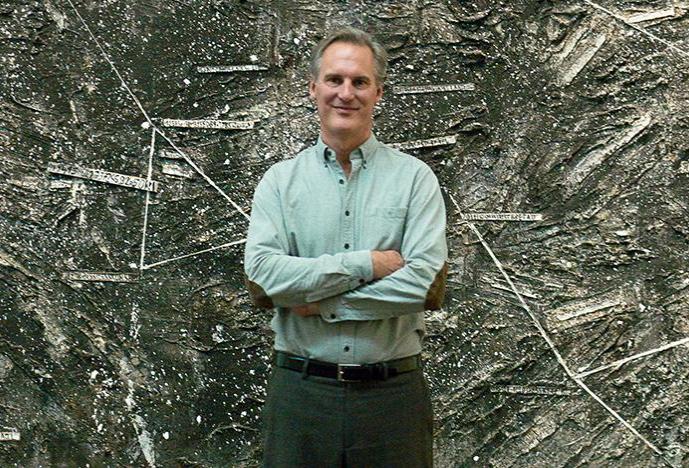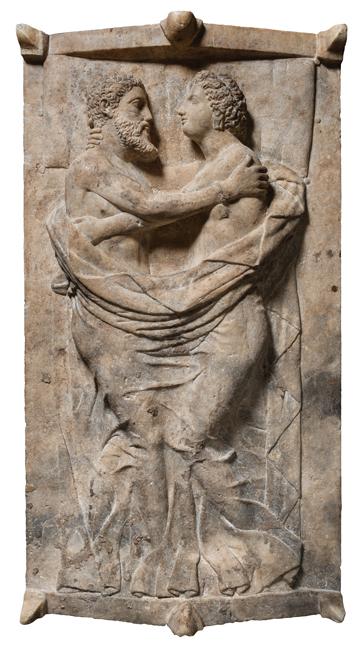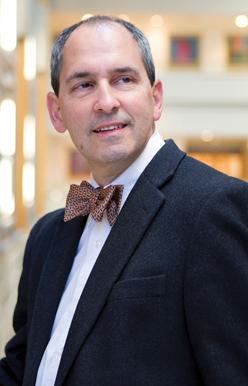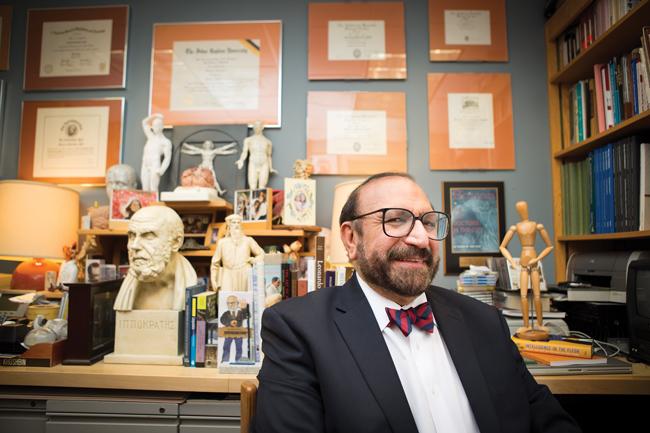Museum Studies
Art unleashes emotions and discussion among new doctors
- 11 minute read
- Feature

On a quiet Thursday night several years ago, Ray Williams was discussing the carvings on an Etruscan sarcophagus, housed in Boston’s Museum of Fine Arts, with a group of internal medicine interns from Brigham and Women’s Hospital. Carved from travertine some 2,300 years ago, the sarcophagus was large, nearly the size of a hospital bed, with a lid that featured a man and a woman lying frozen in a loving embrace, half covered by stone “sheets.”

“They wanted to be buried together, not shown as Greek gods with perfect bodies, but as a middle-aged couple who loved each other,” the art educator told the group of freshly minted doctors. “I picked this work because Ithought it might call up some images from your work in the hospital.”
In the uncomfortable silence that followed, Williams worried he had made a mistake. “Maybe I’m wrong,” he started to apologize. “I was trying to pick something relevant to your experience.”
“No,” said one member of the group, “it’s very relevant.” Just a few days ago, the resident said, he’d told a husband that his wife of fifty years was going to die of cancer. “I was supposed to know what to say,” he continued. “I felt so inadequate.” Other members of the group murmured their deep understanding of this experience, indicating that they, too, felt ill-prepared for these early conversations about death and loss.
“Sharing their feelings of inadequacy was a new experience for these young people,” says Williams, a former director of education at the Harvard Art Museums and now the director of education and academic affairs for the Blanton Museum of Art at the University of Texas at Austin. Since that night, hundreds of HMS interns and residents have gone through a similar exercise, using art as a catalyst for discussions about the challenges and difficulties they face as physicians.

“Taking them out of the wards and into a museum environment,” says Joel Katz, an HMS associate professor of medicine at the School, vice-chair for education in the Department of Medicine at Brigham and Women’s, and director of the hospital’s internal medicine residency program, “can give them needed space to reflect on their experiences in a deeper, more reflective human way.”
“We are committed as a residency program to training great doctors,” he adds. “But we are also committed to creating well cared-for caregivers in order to achieve that goal.”
Beholding
Art is increasingly a part of education programs at medical schools throughout the country. Educators use the paintings and sculptures in nearby museums to help students to not only develop empathy and talk about their feelings but also to hone their diagnostic and communication skills and their ability to work in teams.
“A great work of art doesn’t just copy reality,” says Shahram Khoshbin, an HMS associate professor of neurology at Brigham and Women’s, “it also brings emotion into it. Whenever you bring in emotion, that consolidates memory and aids in learning.”
At HMS, the effort to use art in medical education began more than fifteen years ago when a group of students approached the dean with research showing that the study of art had aided dermatology students at Yale in diagnosing skin conditions. Katz, who had worked as a graphic illustrator before medical school, was intrigued. He contacted Khoshbin, who had written his college thesis on Vincent Van Gogh and epilepsy and was himself an artist.
“Observation is still ninety percent of what we do,” says Khoshbin. “All of our new technologies are not going to change the fact that there is a patient-physician interaction.”
No courses at the time, however, specifically taught visual literacy skills. Katz and Khoshbin developed a course based on Visual Thinking Strategies, a method for teaching children co-developed by Harvard-trained psychologist Abigail Housen and former Museum of Modern Art education director Philip Yenawine. At its core, the course consists of asking three simple questions about artwork: “What’s going on in this picture?” “What do you see that makes you say that?” and “What more can we find?”
Katz and Khoshbin used those questions to create the ten-week class Training the Eye: Improving the Art of Physical Diagnosis for preclinical medical students at HMS. The course includes visits to museums such as the MFA, the Harvard Art Museums, and the Isabella Stewart Gardner Museum to develop visual skills that are then applied in the classroom and to patient care.
“The skill might be deciphering patterns and texture, and then we return and look at dermatology slides,” explains Katz. “Or the skill might be symmetry, and then we review the findings of normal and abnormal cranial nerves.”
Class Project
From the course’s inception, Katz and Khoshbin empirically tested how effectively it trained students. In a 2008 study published in the Journal of General Internal Medicine, Katz, Khoshbin, and their co-researchers described their methodology and findings.
A group of students in the class and a group of control students were shown a set of pictures of artworks and medical conditions before and after the course, then were graded by independent examiners, who were not aware of timing or participation status, on how many accurate observations of medical conditions the students made. When before-course and after-course measures were compared, students who had taken the Training the Eye course improved the frequency of their observations by 38 percent, while the control group showed no such improvement.

“The descriptions of the observations made by members of the test group were far more sophisticated than those of their fellow students,” says Khoshbin.
Improvements to visual skills are only part of what art can provide to doctors’ training, however. In 2008, Barbara Martin, Alfond Curator of Education at the MFA, asked Katz if there were ways that the museum could work with other medical practitioners; the result was a workshop for residents that focused on reflection, empathy, and self-care as well as observation and communication. That overture led to the development of a one-night program in which first-year residents would use art to reflect on their experiences. The program is now part of the Humanistic Curriculum, a required wellness program for internal medicine residents at Brigham and Women’s.
The program consists of five exercises, each lasting around 15 minutes, in which museum educators show the residents different pieces of art in the museum and encourage them to talk about what they see. During a recent meeting, the physicians were introduced to a contemporary work by artist Susie Ganch, part of a recent exhibit at the museum. The work consists of an 11-foot string of recycled objects that tapers from a large aggregation of white disposable spoons and coffee cups to a narrow collection of pink and red buttons and pieces of plastic. The students are asked to talk about how the artwork might be a metaphor for their lives.
“One group decided that, as a beginning resident, you have a lot of information in your brain but as you continue you become more focused, centered, and confident,” says Brooke DiGiovanni Evans, the MFA’s head of gallery learning, who has succeeded Martin as the leader of the program. “Another group had the opposite feeling, that you start with very little knowledge about what you are doing, but as you gain knowledge you realize the greater complexity of the job.”
The specific responses are almost beside the point, compared to the opportunity the experience provides young doctors to talk about the difficulties of their residency—discussions and comparisons that the open-ended nature of contemporary art is capable of triggering. “Contemporary art can be a springboard to use as a way to understand something, to understand yourself,” says Martin.
Physicians who might be reticent to open up in a group discussion at work may be more comfortable sharing their thoughts in the stress-free environment of an art museum. “Doctors mention that the hierarchy that exists in a medical context doesn’t exist in a museum,” says DiGiovanni Evans. “Everyone is pretty much on the same ground in terms of understanding how to engage with a work of art.”
A Level Field
That message is more explicit in a program that Williams developed with Mary Thorndike ’02, an HMS instructor in medicine at Brigham and Women’s. This effort brings teams made up of doctors, nurses, residents, and physical therapists into the museum to discuss art.
“The interpretive problem a work of art poses is comparable to the diagnostic problem a medical case poses,” says Williams. “Rather than looking at art as a solitary experience, they work as a team to solve a complicated interpretive puzzle.”
In the hierarchical setting of a hospital, the opinions of some, particularly those with seniority, carry more weight than those of others. In front of a complex piece of art, however, no one’s expertise is prized over anyone else’s.
“When you realize a medical student had the most important insight and that a nurse then added observations that others hadn’t made, it helps you recognize the importance of everyone’s opinion,” says Katz.
Being confronted with a challenging piece of art also offers a lesson in tolerating ambiguity. In programs for medical teams held at the Harvard Art Museums, Williams always liked to end with a mixed-media sculpture by Rachel Harrison. This piece involves a life-size child mannequin wearing multiple masks, staring up at a torso in a gaudy dress, all topped by a grinning skull. Inevitably, says Williams, teams get stuck on trying to figure out what it means.
“That search for the work’s meaning becomes a conversation about who you are in the face of uncertainty or ambiguity,” he says. “Some people will just bluster through and try to get others to believe them. Others get really quiet and opt out of the conversation.” By examining their own tendencies in the relatively low-stakes venue of the art museum, the team members gain insight into how they might react in a high-stakes medical situation.
Some groups surprised Williams with the way they created meaning together, informed rather than hindered by their experiences in the hospital. One team saw Harrison’s sculpture as one of a child coming to terms with mortality, the green-wigged skull representing the child’s mother. According to Williams, that group then had an entire conversation about what it feels like for this child to be in close proximity to death—and to remain there with integrity. “Something,” Williams adds, “that is not so different from what a physician experiences.”
Noble Truths
The hospital and the art museum, in fact, may not be dissimilar. Both are full of traumatic images that challenge society’s taboos concerning physical contact, nudity, blood, sickness, violent injury, and death.
“For almost every culture, death is one of the points at which they turn to art,” says Martin. “A lot of the art in this building relates in some way to commemorating the dead or honoring the dead or preparing for the afterlife.”

The exercise with the Etruscan sarcophagus, which comes toward the end of the Humanistic Curriculum session, is the one Martin says “almost never fails.” Over the years, she’s seen it unlock raw and moving stories about residents’ experiences—about a wife who climbed into bed with her husband after they requested a do-not-resuscitate order, or about difficult phone calls made to family members, or the sadness of calling lawyers when the person who died had no family to notify.
By creating a space in the museum to broach these topics, the art education programs give residents permission to confront these experiences as humans, not solely as physicians, and to again get in touch with the empathy and compassion that inspired them to practice medicine in the first place.
The final session in the Humanistic Curriculum takes residents into the MFA’s Japanese Temple Room, a cool, dimly lit gallery with five wooden Buddhas in a meditative tableau. There, the facilitators lead the residents in a simple guided meditation.
“We talk about how, if they are going to be healers, they have to take care of themselves, too,” says Martin. As much as art can deal with difficult and traumatic themes, it can also be a source of inspiration and restoration. No matter how challenging the hospital environment can be, the experiences at the museum remind new doctors that personal restoration can be found in art.
Michael Blanding is a Massachusetts-based writer.
Images: Museum of Fine Arts, Boston (top); Reginald Campbell (Williams); John Soares (Katz, Khoshbin, Evans and Martin)